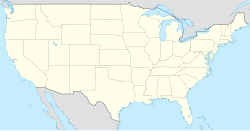Petrified Forest National Park
| Petrified Forest National Park | |
|---|---|
 | |
| Ligger i | USA |
| Område | Arizona |
| Nærmeste by | Holbrook, Navajo County |
| Areal | 378 km² |
| Oprettet | 1962 |
| Årligt besøgstal | 600.000 |
| Oversigtskort | |
Petrified Forest National Park er en nationalpark i delstaten Arizona i USA. Parken blev etableret 9. december 1962, og er på 378 km². Den ligger i Chinle Formation og har en stor koncentration af 225 millioner år gammelt forstenet træ. Det omgivende område, Painted Desert (den malede ørken), har eroderet rødfarvede vulkansk klippe kaldet bentonit. Parken indeholder også kratstepper, farverige ørkenområder og golde eroderede bjergområder. Der er registreret over 600 arkæologiske fund efter tidlige bosætninger – de ældste muligvis over 8.000 år gamle.
Landskabet i parken ligger mellem 1.615 og 1.900 meter over havet, og er en del af Coloradoplateauet. Nationalparken krydses af Interstate 40 (Route 66), og den nordlige del strækker sig ind i Painted Desert. Petrified Forest-området blev udpeget som et National Monument 8. december 1906. Painted Desert blev lagt til på et senere tidspunkt. Den 9. december 1962 blev hele monumentet ændret til nationalpark. Parken er 48 km lang fra nord til syd, og varierer i bredde mellem 19 og 1,9 km. De længste etablerede stier i parken er 3,2 km lange.
Dyrelivet omfatter gaffelbuk, prærieulv, rødlos og Peromyscus maniculatus.
Forstenede træer, de fleste af den uddøde nåletræsslægt Araucarioxylon arizonicum. Fossiler af dyr og planter er for det meste fra yngre trias. Plantefossilene omfatter kongepalmer og gingko, mens dyrefossilene omfatter blandt andet phytosauria, padder og tidlige dinosaurer.
Tyveri af forstenet træ har været et problem for parken i alle år til trods for beskyttelse og at de nærliggende leverandører sælger forsteinet tre som er indsamlet lovligt fra de private områder af parken. Til trods for et vagthold med syv vagtårne med National Park Service Rangers, hegn, varselsignaler og truslen om en bøde på $325 bliver i gennemsnit 12 ton af fossilt tre alligevel stjålet fra nationalparken hvert år.
Se også
Eksterne kilder/henvisninger
Koordinater: 35°04′N 109°47′V / 35.07°N 109.78°V
|
Medier brugt på denne side
Forfatter/Opretter: NordNordWest, Licens: CC BY-SA 3.0
Location map of the United States ("lower 48")
Logo of the United States National Park Service, an agency of the United States Department of the Interior. This version is shaded to look as if it has been carved out of wood or rock. The elements on the logo represent the major facets of the national park system. The Sequoia tree and bison represent vegetation and wildlife, the mountains and water represent scenic and recreational values, and the arrowhead represents historical and archeological values. The bison is also the symbol of the Department of the Interior. The logo became the official logo on July 20, 1951, replacing the previous emblem of a Sequoia cone, and has been used ever since. The design was slightly updated in 2001, and a few different renderings are used today. For more information, see here and here.[dead link]
Map of Petrified Forest National Park — in northeastern Arizona, United States.
- The park is made of colorful and highly erodable Chinle Formation deposits; a 200 Ma year non-deposition occurred at the park, then the Bidahochi Formation, lake deposits and later volcanic tuffs (air fall deposits).
- The Bidahochi Formation is erosion-resistant and can form en:caprocks on specific landforms, or landslide deposits at their base and flanks.
Forfatter/Opretter: Finetooth, Licens: CC BY-SA 3.0
The Tepees in Petrified Forest National Park in northeastern Arizona, United States. View is toward the northwest from the main park road. According to a National Park Service (NPS) document, rock strata exposed in the Tepees area of the park belong to the Blue Mesa Member of the Chinle Formation and are about 220 to 225 million years old. The colorful bands of mudstone and sandstone were laid down during the Triassic, when the area was part of a huge tropical floodplain.
From the Petrified Forest National Park.









